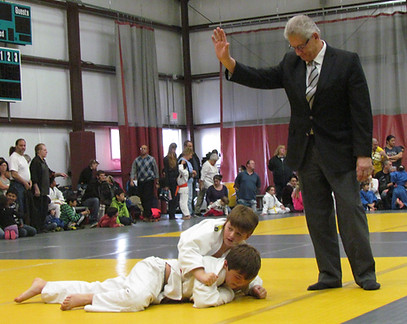Judo Rules & Regulations
Safety
-
Intentionally injuring an opponent is not permitted.
-
Punching, kicking, and other strikes are not allowed.
-
Touching the opponent’s face is not allowed.
-
Attacking joints other than the elbow is not allowed.
-
Head dives are not permitted.
-
The technique known as kawazu gake is not permitted.
-
The technique known as kani basami is not permitted.
-
Wearing any hard or metallic object during competition is not permitted. The penalty for violating this rule is hansoku make (see Penalties, below). This includes wedding rings, earrings, hard-plastic protective gear, hair-ties with metal parts, and even press-studs on underpants.
-
Application of arm bars from a standing position are not permitted

Etiquette
-
Contestants must bow before stepping onto the mat.
-
Contestants must bow to each other before and after practice or competition.
-
Inappropriate behaviour is not tolerated, such as foul language and bodily gestures.
In competition only
-
Stalling is not permitted.
-
Adopting a defensive posture is not permitted.
-
It is required to bow to the competition area.
-
False attacks are not permitted. They are considered attempts to circumvent the prohibition against noncombativity.
-
Disregarding the orders of the judge is prohibited.
Penalties
Two types of penalties may be awarded. A shido (指導) is awarded for minor rule infringements. A shido can also be awarded for a prolonged period of non-aggression. After three shidos are given, the victory is given to the opponent, this is an indirect hansoku-make, and does not result in expulsion from the tournament. The penalty of hansoku make (反則負け) is awarded for major rule infringements, or for accumulating four shidos. If hansoku make is awarded for a major rule infringement, it results not just in loss of the match, but in expulsion from the tournament.
Grips
Rules related to grips are primarily motivated by the desire to avoid stalling, to avoid providing undue advantage, or to reduce the chance of injury.
-
Deliberately avoiding gripping is not permitted.
-
In a standing position, it is not permitted to take any grip other than a “normal” grip for more than three to five seconds without attacking. A “normal” grip is one where the right hand grips some part of the left hand side of the opponent’s jacket (and the left hand grips some part of the right hand side of the opponent’s jacket.) A non-normal grip may involve grabbing the belt or the wrong side of the jacket. (A non-“standard” grip is one that does not involve the traditional sleeve/collar grip. There are no time-limits related to non-“standard” grips as long as they are not non-“normal”.)
-
A “pistol grip” on the opponent’s sleeve is not permitted.
-
It is not permitted to insert the fingers inside the opponent’s sleeve opening or trousers opening at any time. You are permitted to insert your fingers inside your own gi openings.
-
Biting the opponent’s gi is prohibited, as it grants another gripping point.
Age
Judo competitions typically have some safety-related rules related to age: chokes are prohibited under a certain age (typically 13), and arm bars are prohibited under a certain age (typically 17).
The duration of matches is also dependent on the age of the competitors. Match length is typically three minutes for children, five minutes for teenagers and young adults, and three minutes for ‘masters’ (adults thirty years of age or older).
Gi
Rules related to the gi are primarily related either to safety or to preventing contestants from wearing gis that prevent their opponent from being able to get a grip on them.
-
The sleeves of the jacket are not allowed to be too short: they must extend down to no more than 5 cm above the wrists with the arms extended in front of the body.
-
The legs of the trousers are not allowed to be too short: they must extend down to no more than 5 cm above the ankle.
-
Excessive advertising on the gi must be avoided, and may result in a forced loss if an appropriate gi can’t be found.

Medical treatment, illness, and injury
The official IJF rules related to the provision of medical treatment and to the proper handling of situations involving illness or injury are relatively long and involved, since the exact nature and cause of an injury may themselves affect the awarding of the match, and since receiving some types of medical treatment, but not others, automatically ends the match. The latter fact makes it necessary for medical attendants at judo matches to have some understanding of this rather complex aspect of the rules of judo. The medical team is not allowed to enter the fighting area without permission from the mat judge, and if a contestant receives medical treatment he automatically forfeits the match. Nosebleeds, f.ex. can not be treated by the medical team, the contestant must fix it himself with materials provided by the medical team, proper procedure is stuffing cotton balls up the nostrils, while applying tape around the head. If a contestant is rendered unconscious without a choking technique, and is unable to wake up. The medical team has to take immediate action, and they can’t wait for the contestant’s consent, he forfeits the match automatically. A contestant can of course ignore any injuries he has, and keep fighting. This requries that it’s not of any discomfort to the opponent, f.ex. bleeding over your opponent can cause penalties. If the bleeding is tried stopped three times, with no effect, the match is forfeited.
